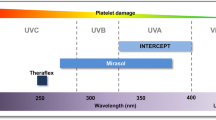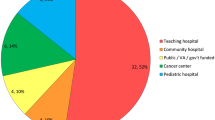Abstract
Screening of platelet concentrates (PCs) for bacterial contamination with cultivation methods is carried out as a routine procedure in some countries. The aim is to prevent the transfusion of contaminated PCs. The German Evaluation of Regular Monitoring Study Group conducted a prospective multicenter study on 52,243 PCs to investigate the prevalence of bacteria (BacT/ALERT, bioMerieux). This study describes the detected bacterial spectrum, the proportion of PCs with a positive test result that had been transfused, and the results of the clinical follow-up. One hundred thirteen (67%) of 169 potentially or confirmed positive units had already been transfused at the time of the first positive signal. The transfusion of units contaminated by Staphylococcus aureus, Serratia marcescens, and 73% of the units contaminated with Staphylococcus epidermidis, Staphylococcus capitis, or Staphylococcus saccharolyticus was prevented. In contrast, 85% of units with Propionibacterium acnes were transfused. A clonal relationship of the isolates from the pooled PCs and from the associated red blood cell concentrates was found in all investigated cases. The follow-up revealed six febrile reactions to culture-positive PCs not classified as transfusion reaction (TRs) by treating physicians. This demonstrates the importance of hemovigilance. Serious septic reactions due to Klebsiella pneumoniae in two units of one apheresis PC that had tested false-negative were reported; one had a fatal outcome. Culture systems reduce the risk of transfusion of contaminated PCs but cannot guarantee sterility. Physicians must be aware of bacterial contamination of PCs as a potential cause of TRs and must report all adverse events.
Similar content being viewed by others
References
de Korte D, Marcelis JH, Verhoeven AJ, Soeterboek AM (2002) Diversion of first blood volume results in a reduction of bacterial contamination for whole-blood collections. Vox Sang 83:13–16
McDonald CP, Roy A, Mahajan P, Smith R, Charlett A, Barbara JA (2004) Relative values of the interventions of diversion and improved donor-arm disinfection to reduce the bacterial risk from blood transfusion. Vox Sang 86:178–182
de Korte D, Curvers J, de Kort WL, Hoekstra T, van der Poel CL, Beckers EA, Marcelis JH (2006) Effects of skin disinfection method, deviation bag, and bacterial screening on clinical safety of platelet transfusions in the Netherlands. Transfusion 46:476–485
te Boekhorst PA, Beckers EA, Vos MC, Vermeij H, van Rhenen DJ (2005) Clinical significance of bacteriologic screening in platelet concentrates. Transfusion 45:514–519
Blajchman MA, Beckers EA, Dickmeiss E, Lin L, Moore G, Muylle L (2005) Bacterial detection of platelets: current problems and possible resolutions. Transfus Med Rev 19:259–272
Munksgaard L, Albjerg L, Lillevang ST, Gahrn-Hansen B, Georgsen J (2004) Detection of bacterial contamination of platelet components: six years’ experience with the BacT/ALERT system. Transfusion 44:1166–1173
Eder AF, Kennedy JM, Dy BA, Notari EP, Weiss JW, Fang CT, Wagner S, Dodd RY, Benjamin RJ (2007) Bacterial screening of apheresis platelets and the residual risk of septic transfusion reactions: the American Red Cross experience (2004–2006). Transfusion 47:1134–1142
Pietersz RN, Engelfriet CP, Reesink HW, Wood EM, Winzar S, Keller AJ, Wilson JT, Henn G, Mayr WR, Ramirez-Arcos S, Goldman M, Georgsen J, Morel P, Herve P, Andeu G, Assal A, Seifried E, Schmidt M, Foley M, Doherty C, Coakley P, Salami A, Cadden E, Murphy WG, Satake M, de Korte D, Bosnes V, Kjeldsen-Kragh J, McDonald C, Brecher ME, Yomtovian R, AuBuchon JP (2007) Detection of bacterial contamination of platelet concentrates. Vox Sang 93:260–277
Hundhausen T, Muller TH (2005) False-positive alarms for bacterial screening of platelet concentrates with BacT/ALERT new-generation plastic bottles: a multicenter pilot study. Transfusion 45:1267–1274
Schrezenmeier H, Walther-Wenke G, Muller TH, Weinauer F, Younis A, Holland-Letz T, Geis G, Asmus J, Bauerfeind U, Burkhart J, Deitenbeck R, Forstemann E, Gebauer W, Hochsmann B, Karakassopoulos A, Liebscher UM, Sanger W, Schmidt M, Schunter F, Sireis W, Seifried E (2007) Bacterial contamination of platelet concentrates: results of a prospective multicenter study comparing pooled whole blood-derived platelets and apheresis platelets. Transfusion 47:644–652
Schmidt M, Karakassopoulos A, Burkhart J, Deitenbeck R, Asmus J, Muller TH, Weinauer F, Seifried E, Walther-Wenke G (2007) Comparison of three bacterial detection methods under routine conditions. Vox Sang 92:15–21
Rossi F, Torriani S, Dellaglio F (1998) Identification and clustering of dairy propionibacteria by RAPD-PCR and CGE-REA methods. J Appl Microbiol 85:956–964
Goering RV, Winters MA (1992) Rapid method for epidemiological evaluation of gram-positive cocci by field inversion gel electrophoresis. J Clin Microbiol 30:577–580
Larsen CP, Ezligini F, Hermansen NO, Kjeldsen-Kragh J (2005) Six years’ experience of using the BacT/ALERT system to screen all platelet concentrates, and additional testing of outdated platelet concentrates to estimate the frequency of false-negative results. Vox Sang 88:93–97
Fang CT, Chambers LA, Kennedy J, Strupp A, Fucci MC, Janas JA, Tang Y, Hapip CA, Lawrence TB, Dodd RY (2005) Detection of bacterial contamination in apheresis platelet products: American Red Cross experience, 2004. Transfusion 45:1845–1852
Kleinman SH, Kamel HT, Harpool DR, Vanderpool SK, Custer B, Wiltbank TB, Nguyen KA, Tomasulo PA (2006) Two-year experience with aerobic culturing of apheresis and whole blood-derived platelets. Transfusion 46:1787–1794
Ramirez-Arcos S, Jenkins C, Dion J, Bernier F, Delage G, Goldman M (2007) Canadian experience with detection of bacterial contamination in apheresis platelets. Transfusion 47:421–429
Störmer M, Kleesiek K, Dreier J (2008) Propionibacterium acnes lacks the capability to proliferate in platelet concentrates. Vox Sang 94:193–201
Clayton JJ, Baig W, Reynolds GW, Sandoe JA (2006) Endocarditis caused by Propionibacterium species: a report of three cases and a review of clinical features and diagnostic difficulties. J Med Microbiol 55:981–987
Perry AL, Lambert PA (2006) Propionibacterium acnes. Lett Appl Microbiol 42:185–188
Zeller V, Ghorbani A, Strady C, Leonard P, Mamoudy P, Desplaces N (2007) Propionibacterium acnes: an agent of prosthetic joint infection and colonization. J Infect 55:119–124
Schneider T, Breviere D, Taillefer MF, Pujol-Rey A, Huart JJ (2000) Bacterial contamination of platelet concentrates by Propionibacterium acnes. Transfus Clin Biol 7:540–546
Kunishima S, Inoue C, Kamiya T, Ozawa K (2001) Presence of Propionibacterium acnes in blood components. Transfusion 41:1126–1129
Apsner R, Winkler S, Schneeweiss B, Horl WH (2000) The shampoo clue: two cases of infection of a ventriculoatrial shunt. Clin Infect Dis 31:1518–1519
Hillyer CD, Josephson CD, Blajchman MA, Vostal JG, Epstein JS, Goodman JL (2003) Bacterial contamination of blood components: risks, strategies, and regulation: joint ASH and AABB educational session in transfusion medicine. Hematology Am Soc Hematol Educ Program 2003(1):575–589
Wolf HH, Leithauser M, Maschmeyer G, Salwender H, Klein U, Chaberny I, Weissinger F, Buchheidt D, Ruhnke M, Egerer G, Cornely O, Fatkenheuer G, Mousset S (2008) Central venous catheter-related infections in hematology and oncology: guidelines of the Infectious Diseases Working Party (AGIHO) of the German Society of Hematology and Oncology (DGHO). Ann Hematol 87:863–876
Seifert H, Cornely O, Seggewiss K, Decker M, Stefanik D, Wisplinghoff H, Fatkenheuer G (2003) Bloodstream infection in neutropenic cancer patients related to short-term nontunnelled catheters determined by quantitative blood cultures, differential time to positivity, and molecular epidemiological typing with pulsed-field gel electro. J Clin Microbiol 41:118–123
Wisplinghoff H, Bischoff T, Tallent SM, Seifert H, Wenzel RP, Edmond MB (2004) Nosocomial bloodstream infections in US hospitals: analysis of 24,179 cases from a prospective nationwide surveillance study. Clin Infect Dis 39:309–317
Martin-Rabadan P, Gijon P, Alcala L, Rodriguez-Creixems M, Alvarado N, Bouza E (2008) Propionibacterium acnes is a common colonizer of intravascular catheters. J Infect 56:257–260
Stainsby D, Russell J, Cohen H, Lilleyman J (2005) Reducing adverse events in blood transfusion. Br J Haematol 131:8–12
Benjamin RJ, Wagner SJ (2007) The residual risk of sepsis: modeling the effect of concentration on bacterial detection in two-bottle culture systems and an estimation of false-negative culture rates. Transfusion 47:1381–1389
Beckers EAM (2007) Effects of bacterial testing: what risks are remaining? ISBT Science Series 2:30–34
Benjamin RJ (2008) Bacterial culture of apheresis platelet products and the residual risk of sepsis. ISBT Science Series 3:133–138
Terpstra FG, van ’t Wout AB, Schuitemaker H, van Engelenburg FA, Dekkers DW, Verhaar R, de Korte D, Verhoeven AJ (2008) Potential and limitation of UVC irradiation for the inactivation of pathogens in platelet concentrates. Transfusion 48:304–313
Solheim BG (2008) Pathogen reduction of blood components. Transfus Apher Sci 39:75–82
Janetzko K, Lin L, Eichler H, Mayaudon V, Flament J, Kluter H (2004) Implementation of the INTERCEPT Blood System for Platelets into routine blood bank manufacturing procedures: evaluation of apheresis platelets. Vox Sang 86:239–245
Acknowledgments
The study was conducted by the German Evaluation of Regular Monitoring Study (GERMS) Group of the Red Cross Transfusion Services and supported by the Forschungsgemeinschaft of the DRK-Blutspendedienste.
Author information
Authors and Affiliations
Corresponding author
Additional information
The GERMS Group consists of the following:
Steering committee
G. Walther-Wenke, MD; T.H. Müller, MD, PhD; A. Younis, MD; F. Weinauer, MD
Participating sites
German Red Cross Blood Service:
Breitscheid (DRK-Blutspendedienst West): R. Deitenbeck, MD
Dresden (DRK-Blutspendedienst Baden-Württemberg – Hessen und Ost) U.-M. Liebscher, MD; E. Förstemann, MD
Frankfurt (DRK-Blutspendedienst Baden-Württemberg – Hessen und Ost): M. Schmidt, MD; W. Sireis, MD; E. Seifried, MD
Ulm (DRK-Blutspendedienst Baden-Württemberg – Hessen und Ost): H. Schrezenmeier, MD; B. Höchsmann, MD; M. Wiesneth, MD
Munich (BRK-Blutspendedienst): J. Burkhart, F. Weinauer, MD
Muenster (DRK-Blutspendedienst West): G. Walther-Wenke, MD
Nuernberg (BRK-Blutspendedienst): W. Sänger, PhD
Oldenburg (DRK-Blutspendedienst NSTOB): F. Schunter, MD; W. Gebauer, MD
Springe (DRK-Blutspendedienst NSTOB): U. Bauerfeind, MD; T.H. Müller, MD, PhD
Microbiology reference laboratories:
Bochum: S.G. Gatermann, MD; G. Geis, PhD
Frankfurt: V. Schäfer, MD
Statistics
Bochum: H.J. Trampisch, PhD; T. Holland-Letz
Manuscript writing group
G. Walther-Wenke, H. Schrezenmeier, G. Geis, R. Deitenbeck
Sponsor
Forschungsgemeinschaft der DRK-Blutspendedienste: E. Seifried, MD; President; H. Frenzel, PhD, Vice President
Rights and permissions
About this article
Cite this article
Walther-Wenke, G., Schrezenmeier, H., Deitenbeck, R. et al. Screening of platelet concentrates for bacterial contamination: spectrum of bacteria detected, proportionof transfused units, and clinical follow-up. Ann Hematol 89, 83–91 (2010). https://doi.org/10.1007/s00277-009-0762-2
Received:
Accepted:
Published:
Issue Date:
DOI: https://doi.org/10.1007/s00277-009-0762-2




